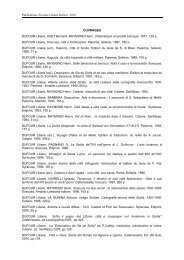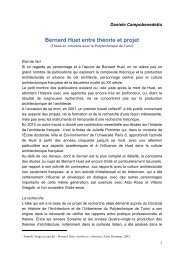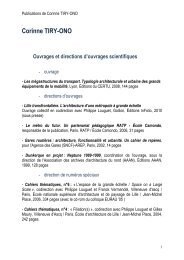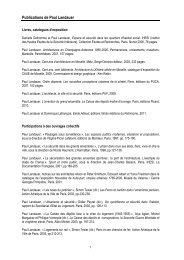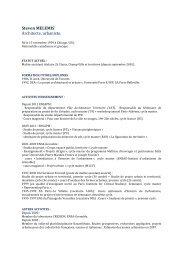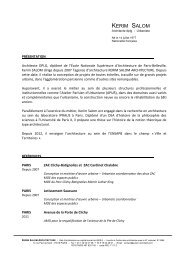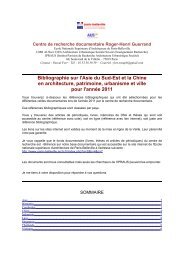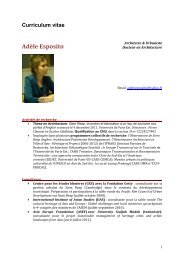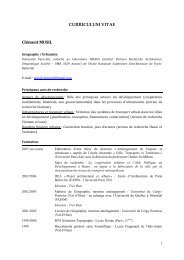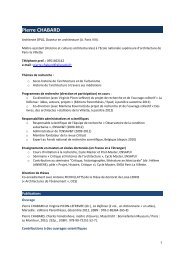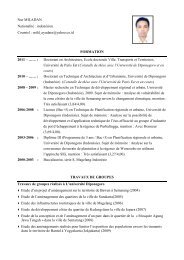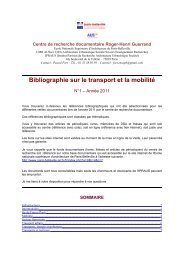Télécharger la veille UMR AUSser sur l'Asie n°6 ... - Site en travaux
Télécharger la veille UMR AUSser sur l'Asie n°6 ... - Site en travaux
Télécharger la veille UMR AUSser sur l'Asie n°6 ... - Site en travaux
You also want an ePaper? Increase the reach of your titles
YUMPU automatically turns print PDFs into web optimized ePapers that Google loves.
C<strong>en</strong>tre de recherche docum<strong>en</strong>taire Roger-H<strong>en</strong>ri GuerrandEcole Nationale Supérieure d'Architecture de Paris-BellevilleIPRAUS – <strong>UMR</strong> AUSSER 332960, boulevard de <strong>la</strong> Villette – 75019 ParisPascal FortTél. : 01 53 38 50 59 – Mél : fort.<strong>en</strong>sapb@gmail.comVeille <strong>UMR</strong> AUSSER <strong>sur</strong> l’AsieN°6 – avril 2012Voici le 6ème numéro du bulletin trimestriel « Veille <strong>UMR</strong> AUSSER <strong>sur</strong> <strong>l'Asie</strong> » dans lequelvous trouverez les rubriques suivantes :- Appels à contribution : France et étranger- Appels d'offre / Programmes de recherche / Bourses : France et étranger- Séminaires/Colloques : France et étranger- Dernières publications : les cartes, livres, périodiques et articles de périodiques sortisrécemm<strong>en</strong>t et traitant de vos thématiques de recherche. En cliquant <strong>sur</strong> les li<strong>en</strong>s, vous aurezles résumés de ces publications. Pour certaines, vous aurez accès directem<strong>en</strong>t à l'intégralitédu docum<strong>en</strong>t.- Thèses : une sélection de thèses qui ont été sout<strong>en</strong>ues récemm<strong>en</strong>t <strong>en</strong> France et dans lemonde et celles qui ont été intégrées à <strong>la</strong> base docum<strong>en</strong>taire du c<strong>en</strong>tre de recherchedocum<strong>en</strong>taire.Ces rubriques ont été proposées par Nathalie Lancret (Directrice de l'<strong>UMR</strong> AUSSER) et jeles ai alim<strong>en</strong>tées par une <strong>veille</strong> <strong>sur</strong> des sites spécialisés <strong>sur</strong> <strong>l'Asie</strong> du Sud-Est.Si vous aviez des informations re<strong>la</strong>tives à ces rubriques, n'hésitez pas à me les faireparv<strong>en</strong>ir pour que je puisse les intégrer dans ce bulletin de <strong>veille</strong>.J'att<strong>en</strong>ds vos observations et propositions afin que cette <strong>veille</strong> réponde au mieux àvos att<strong>en</strong>tes.SOMMAIREAppels à contribution ................................................................................................................................................2Appels d'offre / Programmes de recherche /Bourses ................................................................................................3Séminaires/Colloques ................................................................................................................................................4Dernières publications ...............................................................................................................................................6Thèses ......................................................................................................................................................................14
Appels à contribution7th EuroSEAS Confer<strong>en</strong>ce (Ext<strong>en</strong>sion de <strong>la</strong> date limite au 31/05/2012)Date : 02 au 05 juillet 2013Lieu : Lisboa, Portugal the School of Social and Political Sci<strong>en</strong>ces of the Technical Universityof Lisboa (ISCSP/UTL)Date de réponse avant : 31 mai 2012The Call for Panels is now op<strong>en</strong> until the 31st of May, 2012. Proposals should be s<strong>en</strong>d to:euroseas2013@gmail.com by using the EuroSEAS Panel Proposal Form.The Board is confid<strong>en</strong>t that members will propose a range of diverse panels in line with the high standardsobtained in the past. Members wishing to propose panels are strongly <strong>en</strong>couraged to involvepartners from a differ<strong>en</strong>t institution to guarantee the sort of international co-operation that is a hallmarkof our organization. Young scho<strong>la</strong>rs are welcome to advance panel proposals.Submissions will be accepted in English. The program committee will work with panel organizers to<strong>en</strong><strong>sur</strong>e disciplinary diversity and cont<strong>en</strong>t compatibility. Proposals should be submitted using theEuroSEAS Panel Proposal Form. Panel organizers will be expected to circu<strong>la</strong>te their respective Call forpapers as from the 15th May up to the 15 th September 2012. Panels should typically aim to admitbetwe<strong>en</strong> 6 and 8 papers.The Board will announce the accepted panels no <strong>la</strong>ter than the 31st July, 2012. Panels’ organizersshould s<strong>en</strong>d the panels’ members and their paper abstracts no <strong>la</strong>ter than the 15 th DEcember 2012For further information please keep checking the EuroSEAS website: http://www.euroseas.orgor contact euroseas2013@gmail.comOTHER OPPORTUNITIESThe Board <strong>en</strong>visages to offer alternative opportunities outside formal panels. These include:1. A room to be avai<strong>la</strong>ble for group meetings/discussions/project debates (“Speakers corner”)2. An area for the disp<strong>la</strong>y of PostersAlso, scre<strong>en</strong>ing of movies and staging of musical or other art performances may be contemp<strong>la</strong>ted ifsuffici<strong>en</strong>t interest is manifested in relevant proposals, which should reach the Board by the 31st July,2012
Appels d'offre / Programmes de recherche /BoursesEuropean Institutes for Advanced Study (EURIAS) Fellowship ProgrammeDate limite : 07 juin 2012The European Institutes for Advanced Study (EURIAS) Fellowship Programme is an international researchermobility programme offering 10-month resid<strong>en</strong>cies in one of the 14 participating Institutes:Berlin, Bologna, Brussels, Bucharest, Budapest, Cambridge, Helsinki, Jerusalem, Lyons, Nantes, Paris,Uppsa<strong>la</strong>, Vi<strong>en</strong>na, Wass<strong>en</strong>aar. The Institutes for Advanced Study support the focused, self-directedwork of outstanding researchers. The fellows b<strong>en</strong>efit from the finest intellectual and research conditionsand from the stimu<strong>la</strong>ting <strong>en</strong>vironm<strong>en</strong>t of a multi-disciplinary and international community of firstratescho<strong>la</strong>rs.EURIAS Fellowships are mainly offered in the fields of the humanities and social sci<strong>en</strong>ces but mayalso be granted to scho<strong>la</strong>rs in life and exact sci<strong>en</strong>ces, provided that their proposed research projectdoes not require <strong>la</strong>boratory facilities and that it interfaces with humanities and social sci<strong>en</strong>ces. The diversityof the 14 participating IAS offers a wide range of possible research contexts in Europe forworldwide scho<strong>la</strong>rs. Applicants may select up to three IAS outside their country of nationality or resid<strong>en</strong>ceas possible host institutions.The Programme welcomes applications worldwide from promising young scho<strong>la</strong>rs as well as from leadings<strong>en</strong>ior researchers. The EURIAS selection process has prov<strong>en</strong> to be highly competitive. Tomatch the Programme standards, applicants have to submit a solid and innovative research proposal,to demonstrate the ability to forge beyond disciplinary specialisation, to show an international commitm<strong>en</strong>tas well as quality publications in high-impact v<strong>en</strong>ues.Suite...Programme SIAM 2013Date limite de co-dépôt des dossiers : 16 juillet 2012Prés<strong>en</strong>tation extrait du site : nouvel appel (2013) à projets de recherche du Part<strong>en</strong>ariat Hubert Curi<strong>en</strong>pour <strong>la</strong> Thaï<strong>la</strong>nde.L'objectif de ce programme est de développer les échanges sci<strong>en</strong>tifiques et technologiques d'excell<strong>en</strong>ce<strong>en</strong>tre les <strong>la</strong>boratoires de recherche des deux pays <strong>en</strong> favorisant les nouvelles coopérations. Leprés<strong>en</strong>t appel concerne plusieurs domaines sci<strong>en</strong>tifiques dont Sci<strong>en</strong>ces humaines et sociales, cultureet tourisme.Suite...Bourse de terrain de l'EFEODate : avant le 30 septembre 2012 pour un séjour de terrain <strong>en</strong> Asie <strong>en</strong>tre le 1er juillet et le 31 décembre2013L'École française d'Extrême-Ori<strong>en</strong>t (EFEO) propose des allocations de terrain permettant aux étudiantsd'effectuer un séjour d'étude <strong>en</strong> Asie dans les C<strong>en</strong>tres de l'EFEO ou dans un c<strong>en</strong>tre duConsortium europé<strong>en</strong> ECAF.
Séminaires/ColloquesVille Alternative : Nouveaux espaces – Nouvelles perspectivesCycle de confér<strong>en</strong>ces et débats d’idées organisé par l’ambassade de France <strong>en</strong> Chine etl’Institut français, 2012Lieu : Pékin, UCCA (Ull<strong>en</strong>s C<strong>en</strong>ter for Contemporary Art)Date : Avril à décembre 2012Prés<strong>en</strong>tation extrait du site : Dans <strong>la</strong> modernité d’une grande ville, il arrive le mom<strong>en</strong>t où l’alternativeéclot, fruit d’un désir autant que d’une nécessité. DESIR de vivre autrem<strong>en</strong>t <strong>la</strong> ville, de se l’approprier,d’<strong>en</strong> être l’acteur dynamique et inv<strong>en</strong>tif. NECESSITE, pour éviter d’étouffer sous le poids de contrainte<strong>sur</strong>baines induites par les évolutions économiques et les choix politiques.L’ambassade de France <strong>en</strong> Chine et l’Institut français, <strong>en</strong> part<strong>en</strong>ariat avec l’atelier Sinapolis, prés<strong>en</strong>t<strong>en</strong>tun cycle de confér<strong>en</strong>ces et débats consacré à La Ville Alternative : Nouveaux espaces –Nouvelles perspectives. Ce cycle a vocation d’aborder <strong>la</strong> ville dans ses dim<strong>en</strong>sions culturelles, sociétalesou id<strong>en</strong>titaires décortiquées au travers d’expéri<strong>en</strong>ces françaises et chinoises, liant aussi bi<strong>en</strong>l’histoire que <strong>la</strong> période contemporaine.Ce cycle introduira dans le débat les thématiques culturelles, sociales, politiques, <strong>en</strong>vironnem<strong>en</strong>tales,philosophiques qui façonn<strong>en</strong>t nos villes… Les confér<strong>en</strong>ces s’axeront tout au long de l’année, dansplusieurs villes de Chine (Pékin, Shanghai, Hangzhou, Whuhan…) autour des quatre modules suivants:• Avril 2012 « Activisme urbain – Qui sont les acteurs ce <strong>la</strong> ville alternative ? »• Mai-juin 2012 « Citoy<strong>en</strong>netés alternatives dans <strong>la</strong> ville contemporaine – Perspectives francochinoises»• Septembre 2012 « Ville réelle / Ville rêvée »• Novembre 2012 « Construire <strong>la</strong> ville de demain »Cultural Exchange betwe<strong>en</strong> Europe and Southeast Asia: A SymposiumLieu : Seattle University in Seattle, WA, USADate : 26 et 27 mai 2012Prés<strong>en</strong>tation : This symposium focuses on the patterns and networks of cultural interaction, exchange,and mutual curiosity betwe<strong>en</strong> Europe and Southeast Asia as well as Sri Lanka (Ceylon). While someof the papers use frameworks of empire, others highlight themes that are oft<strong>en</strong> overlooked or obscuredwh<strong>en</strong> focusing on the frameworks of empires and nation-states. Issues of heritage are also highlighted.dont :Architecture and Urbanism"Technical Exchanges in Colonial Vietnam: a Missed R<strong>en</strong>dez-Vous?"Caroline Herbelin, Université de Toulouse 2 Le Mirail, France“Modernizing Cambodia Under Norodom Sihanouk”Linda Saphan, Manhattan College“Rejecting and Reproducing Colonial Urbanism in Contemporary Ma<strong>la</strong>ysian City Design”Sarah Moser, University of Massachusetts Lowell
URBACHINA meetingLieu : RomeDate : 28 au 30 mai 2012Prés<strong>en</strong>tation : The URBACHINA consortium meeting that will take p<strong>la</strong>ce on 28th-30th May in Romewill allow its members to review the project's progress. In addition, this will be an opportunity for itsSci<strong>en</strong>tific Committee to meet for the first time, of whom include: Professor Perkins, Professor Sh<strong>en</strong>,Jacques Veron, Michel Prouzet and Karl Hallding.The meeting will be followed by a visit of the city that will <strong>en</strong>able issues of urbanisation to be discussed.4th Southeast Asian Archaeology WorkshopLieu : Maison de <strong>l'Asie</strong>, 22 av<strong>en</strong>ue du Présid<strong>en</strong>t Wilson, 75016 ParisDate : 29 juin 2012Résumé extrait du site : From its foundation at UCL in 2006, the biannual Workshop has be<strong>en</strong>int<strong>en</strong>ded to provide a predominantly Anglo-Fr<strong>en</strong>ch forum for the informal dissemination and discussionof state-of-the-art regional research, particu<strong>la</strong>rly from post-graduate and post-doctoral scho<strong>la</strong>rs,complem<strong>en</strong>tary to the <strong>la</strong>rger international format of the European Association of Southeast AsianArchaeologists meetings.Rec<strong>en</strong>t and <strong>la</strong>udable advances in archaeobotanical "Indian Ocean" research have only emphasisedthe dearth of material culture data on this topic, especially pottery, and thus, for 2012, the Workshopwill have a specific focus on "Ceramics re<strong>la</strong>ted to maritime exchange networks betwe<strong>en</strong> theIndian Ocean and South China Sea, c. 500 BC to c. 500 AD."Confirmed speakers include:Yvette Balbaligo (UCL), Phaedra Bouvet (Paris III), Franca Cole (Cambridge), Coline Lefrancq(Université Libre de Bruxelles), and Noémie Martin (CEROI-INALCO), offering geographical coveragefrom Indonesia and the Philippines, littoral China, Vietnam, Cambodia, Thai<strong>la</strong>nd, and Ma<strong>la</strong>ysia in theEast, to Bang<strong>la</strong>desh, India, Sri Lanka, and Madagascar in the West.Slots for pres<strong>en</strong>tations remain op<strong>en</strong> to proposals within a 25 minute oral + 5 minute questions format,with pl<strong>en</strong>ty of time left for ext<strong>en</strong>ded discussion. The workshop is free and op<strong>en</strong> to all, and we lookforward to welcoming you to Paris this summer.Colloque 2012 de l’ACEA (Association Canadi<strong>en</strong>ne des Etudes Asiatiques)Lieu : Université du Québec à MontréalDate : 02 au 04 novembre 2012Résumé extrait du site : Tous les deux ans, le colloque de l’ACEA est le forum où se r<strong>en</strong>contr<strong>en</strong>t leschercheurs canadi<strong>en</strong>-ne-s travail<strong>la</strong>nt <strong>sur</strong> toutes les régions d’Asie, les canadi<strong>en</strong>-ne-s ayant unhéritage asiatique, ainsi que ceux et celles qui s’intéress<strong>en</strong>t aux li<strong>en</strong>s que le Canada <strong>en</strong>treti<strong>en</strong>t aveccette région du monde. Cet événem<strong>en</strong>t accueille chercheurs, étudiant-e-s, décideurs publics etacteurs de <strong>la</strong> société civile, intéressé-e-s par l’Asie dans son acceptation <strong>la</strong> plus <strong>la</strong>rge. Le congrès estun événem<strong>en</strong>t dont <strong>la</strong> dim<strong>en</strong>sion est nationale, mais aussi internationale, puisqu’il rassemble desasianistes canadi<strong>en</strong>-ne-s et étrangers. Il permet d’offrir une perspective canadi<strong>en</strong>ne distincte <strong>sur</strong> les<strong>en</strong>jeux que prés<strong>en</strong>t<strong>en</strong>t l’Asie pour notre pays, mais aussi de pr<strong>en</strong>dre <strong>en</strong> compte <strong>la</strong> richesse del’héritage asiatique au Canada et les rôles passé, actuel et futur de <strong>la</strong> communauté asiatiquecanadi<strong>en</strong>ne.Le comité <strong>en</strong>courage fortem<strong>en</strong>t les soumissions de propositions de séances consacrées à une thématiqueprécise. Il accueillera égalem<strong>en</strong>t des propositions issues de toutes les disciplines des sci<strong>en</strong>cessociales et des sci<strong>en</strong>ces humaines et <strong>en</strong>courage <strong>la</strong> constitution de panels inter- et multi-disciplinaires.Les séances <strong>en</strong> question peuv<strong>en</strong>t être des tables rondes où plusieurs experts universitaires ou de <strong>la</strong>société civile discuteront de leurs <strong>travaux</strong> et de leurs intérêts, ou <strong>en</strong>core des prés<strong>en</strong>tations de trois ouquatre projets de recherches. Pour plus d’informations <strong>sur</strong> le colloque et l’inscription, consultez le sitede l’ACEA, à l’adresse suivante : http://www.casa-acea.ca/?page_id=750
Dernières publications1 - Articles de revuesArticles <strong>en</strong> ligneChineLIN Yanliu, MEULDER Bruno de - « A conceptual framework for the strategic urban projectapproach for the sustainable redevelopm<strong>en</strong>t of “vil<strong>la</strong>ges in the city” in Guangzhou » - In Habitatinternational Vol.36, Issue n°3 de juillet 2012 – pp. 380-387(Accès avec code Biblioshs)Abstract : China’s rec<strong>en</strong>t wave of rapid urbanization g<strong>en</strong>erated a specific form of urban developm<strong>en</strong>tcalled the “vil<strong>la</strong>ge in the city” (ViC). It is characterized by the dual urban-rural structure and it accommodates,to begin with, the monum<strong>en</strong>tal housing needs of rural migrants. Although the issues of ViCsare very specific and <strong>en</strong>ormous, they evid<strong>en</strong>tly have a lot in common with those of slum areas and di<strong>la</strong>pidatedurban areas in developed and developing contexts, in which there already is a long experi<strong>en</strong>cewith upgrading or urban r<strong>en</strong>ewal operations. Also in this specific context of upgrading and urbanr<strong>en</strong>ewal, the strategic urban project approach is g<strong>en</strong>erally being advocated. It emphasizes visiondevelopm<strong>en</strong>t, the coproduction by stakeholders and the implem<strong>en</strong>tation of actions. Strategic urbanprojects are the cornerstone of this approach. This paper sketches a conceptual framework for thestrategic urban project approach for the sustainable redevelopm<strong>en</strong>t of “vil<strong>la</strong>ges in the city” (ViCs) inGuangzhou. It makes an attempt to trans<strong>la</strong>te the methodologies of the strategic urban project approachto the Chinese context. Adapting the method to deal with the multi-stakeholder <strong>en</strong>vironm<strong>en</strong>tand complex issues in ViCs is indeed necessary in order to obtain a sustainable redevelopm<strong>en</strong>t ofViCs. Consideration is giv<strong>en</strong> to the roles and partnerships of key stakeholders, visions at differ<strong>en</strong>t levels,and specific actions that deal with opportunities and issues in strategic locations.SINAPOLIS – Articles et <strong>veille</strong> d'informationsCe blog vise à décortiquer les manières de faire, vivre, p<strong>en</strong>ser et représ<strong>en</strong>ter <strong>la</strong> ville <strong>en</strong> Chine. Dansune perspective de débat é<strong>la</strong>rgi et <strong>sur</strong> une forme libre, il permettra aux lecteurs de se docum<strong>en</strong>ter autravers d'<strong>en</strong>treti<strong>en</strong>s, de lectures, de docum<strong>en</strong>ts photographiques, de supports médiatiques ou alternatifs,d'analyses simples ou complexes... Bi<strong>en</strong> <strong>en</strong>t<strong>en</strong>du, nous <strong>la</strong>nçons ce blog dans l'optique d'une évolutionqualitative, votre retour, participation ou vos suggestions nous import<strong>en</strong>t donc beaucoup.Contactez-nous <strong>sur</strong> : resources@sinapolis.netTANG Ying, MASON Robert J., SUN Ping - « Interest distribution in the process of coordinationof urban and rural construction <strong>la</strong>nd in China » - In Habitat international Vol.36, Issue n°3 de juillet2012 – pp. 388-395(Accès avec code Biblioshs)Abstract : Since the onset of rapid economic developm<strong>en</strong>t and urbanization, China’s <strong>la</strong>nd resources—rather than capital, technology and human resources—have become the lead limiting factor inconstraining economic growth. Coordination of urban and rural construction <strong>la</strong>nd (CURCL) can be avery effective means for reducing conflicts betwe<strong>en</strong> economic developm<strong>en</strong>t and <strong>la</strong>nd protection. Thisresearch examines the roles of stakeholders involved in the CURCL process. The reasons why the interestsof legitimated stakeholders were <strong>en</strong>croached upon are analyzed and countermea<strong>sur</strong>es to protectthe interests of legitimated stakeholders are proposed. Ambiguously defined property rights forowners of rural construction <strong>la</strong>nd, unclear conceptions of the public interest, and over<strong>la</strong>p of power andinterest among multiple levels of authority are the reasons why legitimated stakeholders’ interestswere <strong>en</strong>croached upon. Legitimizing construction <strong>la</strong>nd ownership clearly, better defining the multipleconceptions of public interest, op<strong>en</strong>ing up express channels for expression of the public interest, andc<strong>la</strong>rifying governm<strong>en</strong>ts’ functions in <strong>la</strong>nd interest adjustm<strong>en</strong>t are the countermea<strong>sur</strong>es to protect theinterests of legitimated stakeholders.
Ye Hua D<strong>en</strong>nis Wei - « Restructuring for growth in urban China: Transitional institutions, urbandevelopm<strong>en</strong>t, and spatial transformation » - In Habitat international Vol.36, Issue n°3 de juillet 2012– pp. 396-405(Accès avec code Biblioshs)Abstract : This research examines governm<strong>en</strong>t policies and urban transformation in China through astudy of Hangzhou City, which is undergoing dramatic growth and restructuring. As the southern c<strong>en</strong>terof the Yangtze River Delta, an emerging global city region of China, Hangzhou has be<strong>en</strong> restlesslysearching for strategies to promote economic growth and <strong>sur</strong>vive the competition with Shanghai. Thispaper analyzes Hangzhou’s developm<strong>en</strong>t strategies, including globalization, tourism, industrial developm<strong>en</strong>t,and urban developm<strong>en</strong>t, in the context of shifting macro conditions and local responses. Wehold that urban policies in China are situated in the broad economic restructuring and the gradual, experi<strong>en</strong>tialnational reform and are therefore transitional. The paper suggests that China’s urban policiesare state institution-directed, growth-ori<strong>en</strong>ted, and <strong>la</strong>nd-based, imposing unpreced<strong>en</strong>ted chall<strong>en</strong>gesto sustainability and livability. Land developm<strong>en</strong>t and spatial restructuring are c<strong>en</strong>tral to urbanpolicies in China. Last, while Hangzhou’s developm<strong>en</strong>t strategies and policies to some ext<strong>en</strong>t reflectpolicy converg<strong>en</strong>ce across cities in China, local/spatial contexts, including local settings, territorial rescalingand <strong>la</strong>nd conditions, are underlying the functioning of developm<strong>en</strong>t/<strong>en</strong>trepr<strong>en</strong>eurial states.YUNG Esther H.K., CHAN Edwin H.W. - « Implem<strong>en</strong>tation chall<strong>en</strong>ges to the adaptive reuse ofheritage buildings: Towards the goals of sustainable, low carbon cities » - In Habitat internationalVol.33, Issue n°3 de juillet 2012 – pp. 352-361(Accès avec code Biblioshs)Abstract : It is well acknowledged that low carbon emissions is one of the key factors contributing tosustainable urban developm<strong>en</strong>t and effectively tackling climate change. Adaptive reuse of buildings isa form of sustainable urban reg<strong>en</strong>eration, as it ext<strong>en</strong>ds the building's life and avoids demolition waste,<strong>en</strong>courages reuses of the embodied <strong>en</strong>ergy and also provides significant social and economic b<strong>en</strong>efitsto the society. Thus, it embraces the differ<strong>en</strong>t dim<strong>en</strong>sions of sustainability. However, the debates overwhich sustainability factors are key, and how to address them all in practice, remain unresolved. Thisstudy begins with an int<strong>en</strong>sive literature review of the factors that contribute to the goal of sustainabledevelopm<strong>en</strong>t in the conservation of built heritage. This is followed by in-depth interviews with practitionerswho have participated in adaptive reuse projects in Hong Kong. These interviews confirm the reliabilityof the shortlisted sustainability factors. More importantly, this paper examines the chall<strong>en</strong>ges inincorporating a sustainability framework into adaptive reuse projects. The authors stress that the frameworkfor achieving sustainable, low carbon adaptive reuse should be viewed more holistically, integratingsocial, economic, <strong>en</strong>vironm<strong>en</strong>tal, urban and political policies.Vietnam« Bulletin du PADDI n°5 » d'avril 2012 – C<strong>en</strong>tre de prospective et d'études urbaines – 6 p."Vietnam Urban Briefs" n°1 d'avril 2012 – 4 p.Prés<strong>en</strong>tation : Note m<strong>en</strong>suelle <strong>sur</strong> <strong>la</strong> question urbaine publiée par <strong>la</strong> Banque MondialeRéfér<strong>en</strong>cem<strong>en</strong>t d'articleChineBOUFFLET Stéphanie, FERRARI Béatrice, YU Wang - « Chine, <strong>la</strong> nouvelle recherche urbaine » -In Urbanisme n°383 de mars-avril 2012 – pp. 36-40Ce n° est consultable au c<strong>en</strong>tre de recherche docum<strong>en</strong>tairePrés<strong>en</strong>tation extrait de <strong>la</strong> revue : Derrière l'irrésistible croissance des villes chinoises, des dynamique<strong>sur</strong>baines, sociales et <strong>en</strong>vironnem<strong>en</strong>tales complexes sont à l'oeuvre. Elles mett<strong>en</strong>t notamm<strong>en</strong>t <strong>en</strong> jeu<strong>la</strong> question des migrants et celle du dev<strong>en</strong>ir des territoires périurbains. La nouvelle recherche urbainechinoise <strong>en</strong> a fait des objets d'étude privilégiés. Stéphanie Boufflet, Béatrice Ferrari et Wang Yu, chercheuses,nous <strong>en</strong> prés<strong>en</strong>t<strong>en</strong>t un premier panorama
DUPERREX Matthieu, DUTRAIT C<strong>la</strong>ire (Dir.) - « Shanghai - No City Guide » - La Revue de villes(revue électronique) – Urbain, trop urbain, 2012 – 714 p.Prés<strong>en</strong>tation par l'éditeur : Mégalopole de vitesse et de changem<strong>en</strong>t perman<strong>en</strong>t, Shanghai contredit <strong>la</strong>fixité et l’idéal de ce qu’on appelle <strong>en</strong>core ville. Au visiteur imaginaire ou réel, au nouveau flâneur urbainéquipé de son outil<strong>la</strong>ge numérique, Shanghai Nø City Guide délivre une exploration loin du récitomnisci<strong>en</strong>t. La texture urbaine qui se tisse ainsi à propos de Shanghai devi<strong>en</strong>t une invitation à seconstituer soi-même des approches parcel<strong>la</strong>ires et éc<strong>la</strong>tées, des pratiques urbaines…A rebours du guide de voyage traditionnel, Shanghai Nø City Guide appréh<strong>en</strong>de <strong>la</strong> ville par son dehors:imaginaires, espaces indécis, zones, chantiers et parcours qu’on ne trouvera pas ailleurs et qu<strong>en</strong>ous interrogeons à partir des pratiques qu’ils suscit<strong>en</strong>t… lorsque nous nous détachons de notre rôlede touriste ou de résid<strong>en</strong>t. Proposition expérim<strong>en</strong>tale et créative, fiction numérique mê<strong>la</strong>nt les médiaset les écritures urbaines <strong>en</strong> une forme éditoriale innovante, Shanghai Nø City Guide vise avant tout àcréer un univers de r<strong>en</strong>contre avec cette mégalopole de vitesse et de changem<strong>en</strong>t perman<strong>en</strong>t qu’estShanghai.JIAWEN Yang, QING Sh<strong>en</strong>, JINZHEN Sh<strong>en</strong>, CANFEI He - « Transport Impacts of ClusteredDevelopm<strong>en</strong>t in Beijing: Compact Developm<strong>en</strong>t versus Overconc<strong>en</strong>tration » - In UrbanStudiesvol.49 <strong>n°6</strong> de mai 2012 – pp.1315-1331Abstract : This research aims to inform the compact city discussion with a case study of Beijing, whereurban p<strong>la</strong>nning has emphasised clustered suburban developm<strong>en</strong>t in the past half-c<strong>en</strong>tury. It usesthree decades of c<strong>en</strong>sus data to describe Beijing’s spatial developm<strong>en</strong>t trajectory and a household<strong>sur</strong>vey to assess its transport impacts. The research reveals an overconc<strong>en</strong>tration of urban activitiesas a result of the featureless expansion of the c<strong>en</strong>tral built-up area and the absorption of the suburbanclusters; and, a l<strong>en</strong>gth<strong>en</strong>ed commuting time stemming from the observed spatial developm<strong>en</strong>t pattern.Beijing’s experi<strong>en</strong>ce adds to the existing literature by informing the search for good city forms in urbanareas of high d<strong>en</strong>sity. It is ess<strong>en</strong>tial to differ<strong>en</strong>tiate compact developm<strong>en</strong>t from overconc<strong>en</strong>trationwh<strong>en</strong> combating sprawling developm<strong>en</strong>t. Developing and maintaining suburban nodal characteristicsaround public transit can reduce travel in high-d<strong>en</strong>sity urban areas.JaponTIRY-ONO Corinne - " Maki et les formes collectives. Une leçon singulièrem<strong>en</strong>t nippone ? ", InMarnes, docum<strong>en</strong>ts d’architecture, n° 2, 2012 - p. 170-187.Avec les traductions <strong>en</strong> français de textes de Fumihiko Maki tirés durecueil "Investigations in Collective Form" (1964) :" Les trois paradigmes de <strong>la</strong> forme collective "," La liaison dans <strong>la</strong> forme collective",et de sa prés<strong>en</strong>tation <strong>en</strong> 2008 : " La forme collective ", p. 188-231.Il s'agit du n° 2 de <strong>la</strong> revue "Marnes : Docum<strong>en</strong>ts d'architecture", éditéepar l'École d'architecture de <strong>la</strong> ville et des territoires(Marne-<strong>la</strong>-Vallée), qui vi<strong>en</strong>t de paraître (mars 2012).La particu<strong>la</strong>rité de cette revue est — <strong>en</strong>tre autres — de publier destraductions, inédites ou revues, de textes fondam<strong>en</strong>taux d'architectes oude théorici<strong>en</strong>s de l'architecture.Les traducteurs sont des chercheurs . Ils introduis<strong>en</strong>t leurs traductions annotées par un article.
2 - OuvragesConsultable au c<strong>en</strong>tre de recherche docum<strong>en</strong>taireAsieCHANDLER David, GOSCHA Christopher E. - « L'espace d'un regard : <strong>l'Asie</strong> de Paul Mus (1902-1969) » - Paris : Les Indes savantes, 2006 – 335 p.Cote : I5.1.CHA1Résumé extrait du site de l'éditeur : Paul Mus fut un érudit et un homme d'action. Ses écrits pénétrants<strong>sur</strong> l'Inde et <strong>l'Asie</strong> du Sud-Est anci<strong>en</strong>nes sont aussi célèbres que sa prise de position contre <strong>la</strong>guerre franco-vietnami<strong>en</strong>ne. Les actes de colloque publié ici révèl<strong>en</strong>t pour <strong>la</strong> première fois ces deuxaspects majeurs de son ouvre ainsi que son influ<strong>en</strong>ce extraordinaire tant <strong>en</strong> France qu'à l'étranger.Pour Mus, il fal<strong>la</strong>it toujours essayer de voir le plus c<strong>la</strong>irem<strong>en</strong>t possible. Et c'était généralem<strong>en</strong>t un déchiffrem<strong>en</strong>tméticuleux et pluridisciplinaire de l'aspect figuré d'un ouvrage, d'un discours, d'un monum<strong>en</strong>tarchitectural ou d'un acte humain qui révé<strong>la</strong>it bi<strong>en</strong> souv<strong>en</strong>t son s<strong>en</strong>s réel. On trouvera certes iciun hommage, mais égalem<strong>en</strong>t l'exploration critique de sa p<strong>en</strong>sée sci<strong>en</strong>tifique, de ses actions, de seséchecs et chagrins. Enfin <strong>la</strong> remarquable mise <strong>en</strong> commun d'un patrimoine de savoirs érudits et d'expertises<strong>sur</strong> <strong>l'Asie</strong> et, aussi, <strong>sur</strong> l'Occid<strong>en</strong>t. Car Paul Mus nous invite toujours à un retour <strong>sur</strong> nousmêmes.KITAMURA Maïe - « La citée fortifiée de Lo Manthang, Mustang, Nord du Népal. Le mur d'<strong>en</strong>ceinte,structure et symbolique d'un site unique dans le monde de culture tibétaine » - Paris :Editions Recherches, 2011- 205 p.Cote : I5.5.2.KIT1Résumé extrait du site de l'éditeur :La petite cité de Lo Manthang est <strong>la</strong> capitale historique de l’anci<strong>en</strong>ne principauté de Lo, région de<strong>la</strong>ngue et de culture tibétaines située aux confins du Népal et de <strong>la</strong> Chine. Ses habitants ont su maîtrisercette terre aride battue par les v<strong>en</strong>ts et ils y édifièr<strong>en</strong>t au XV e siècle, <strong>en</strong> moins de cinquante ans,une cité fortifiée unique dans l’aire de culture tibétaine.Chine« La gestion des fleuves dans <strong>la</strong> stratégie d'expansion régionale de <strong>la</strong> Chine » - Paris : L'Harmattan,2011- 188 p.Cote : I5.1.GES1Résumé extrait du site de l'éditeur :En Chine, les ressources hydrauliques sont <strong>sur</strong>exploitées <strong>en</strong> interne, <strong>en</strong>traînant de nombreux problèmes<strong>en</strong>vironnem<strong>en</strong>taux, sanitaires, économiques et sociaux. La Chine profite de sa position <strong>en</strong>amont des plus grands fleuves asiatiques pour faire pression <strong>sur</strong> ses voisins, provoquant par là mêmeune recrudesc<strong>en</strong>ce des hostilités à ses frontières. Le gouvernem<strong>en</strong>t semble faire le pari de <strong>la</strong> déme<strong>sur</strong>eavec de nouveaux projets titanesques qui pourrai<strong>en</strong>t m<strong>en</strong>acer de façon sérieuse <strong>la</strong> stabilité régionale.« Social Housing in China » - T+A (Time + Architecture) n°4 de juillet 2011 – Shanghai : College ofArchitecture and Urban P<strong>la</strong>nning, Tongji University, 2011 – 173 p.Cote : I5.2.5.SOC1
CHANGFU Wu, SHUONING Tang, ZHENYU Xie - « Yearbook of Tongji urban architectural design2009-2010 » - Shanghai : Tongji university press, 2012 – 191 p.Cote : I5.2.5.YEA1Résumé extrait de <strong>la</strong> revue :This issue of Time+Architecture offers reflections on the above issues by exploring Shanghai's practical experi<strong>en</strong>cein the construction of social housing.En ligneVietnamBANQUE MONDIALE - "Vietnam Urbanization review - Technical assistance report" – novembre2011 - 263 p.Abstract : As Vietnam <strong>en</strong>ters a crucial period of urbanization corresponding to its pres<strong>en</strong>t stage of economicdevelopm<strong>en</strong>t, the Governm<strong>en</strong>t of Vietnam has p<strong>la</strong>ced strong emphasis on developing its systemof cities. In accordance with this objective this Urbanization ... See More + Review is dedicatedto understanding the key dim<strong>en</strong>sions and aspects of Vietnam's urbanization process and to id<strong>en</strong>tifyingtr<strong>en</strong>ds, opportunities, chall<strong>en</strong>ges and core policy priorities that the governm<strong>en</strong>t will need to address inorder to realize its objective. The Vietnam Urbanization Review was prepared following ext<strong>en</strong>siveconsultations with various stakeholders, including officials from national and local governm<strong>en</strong>t, privatesector groups and international and bi<strong>la</strong>teral organizations active in developm<strong>en</strong>t assistance in the urbansector in Vietnam. It builds on a strong portfolio of World Bank <strong>en</strong>gagem<strong>en</strong>ts in investm<strong>en</strong>t andpolicy l<strong>en</strong>ding to the Governm<strong>en</strong>t of Vietnam. It also builds on a number of more in-depth studies thatwere commissioned specifically for the Vietnam urbanization review.Seulem<strong>en</strong>t le résumé <strong>en</strong> ligne ou li<strong>en</strong> vers le site producteur(En cliquant <strong>sur</strong> le li<strong>en</strong>, vous aurez plus d'informations <strong>sur</strong> ces ouvrages (résumé))AsieJAMMES Jérémy, TREGLODE B<strong>en</strong>oît de - « L'Asie du Sud-Est 2012. les événem<strong>en</strong>ts majeurs del'année » - Paris/Bangkok, Les Indes savantes/ IRASEC, 2012, 390 p.Résumé extrait du site de l'éditeur : Chaque année l'Institut de recherche <strong>sur</strong> <strong>l'Asie</strong> du Sud-Estcontemporaine (Irasec), basé à Bangkok, analyse les principaux événem<strong>en</strong>ts politiques, économiques,sociaux, <strong>en</strong>vironnem<strong>en</strong>taux ou religieux <strong>sur</strong>v<strong>en</strong>us dans l'<strong>en</strong>semble du sous-contin<strong>en</strong>t asiatique.Établissant une rétrospective des principaux événem<strong>en</strong>ts de l'année 2011, ce livre aide à mieuxcompr<strong>en</strong>dre les grands <strong>en</strong>jeux de l'année 2012 dans une région de près de 600 millions d'habitantsqui, plus que jamais, joue un rôle d'interface <strong>en</strong>tre les grands pôles asiatiques. Grâce au travail de terraintout au long de l'année d'une vingtaine de chercheurs et d'experts europé<strong>en</strong>s et asiatiques, Asiedu Sud-Est 2012 offre un décryptage d'une actualité asiatique complexe, d<strong>en</strong>se et dynamique.LIMIN Hee, BOONTHARM Davisi & VIRAY Erwin - « Future Asian Space: Projecting the UrbanSpace of New East Asia » - 2012 – 256 p.Résumé extrait du site de l'éditeur : Rapid technological, economic, social and cultural changes aretransforming the idea of "Asian space." With the shift to a global economy and an urban popu<strong>la</strong>tion explosion,Asian cities have become a mainstay of progress, national pride, id<strong>en</strong>tity, and positioning onthe global stage. The extraordinary pace and int<strong>en</strong>sity of the changes have created a situation uniquein the history of urban developm<strong>en</strong>t.Despite the imm<strong>en</strong>se diversity of Asian countries, "Asia-ness" is oft<strong>en</strong> treated as a distinctive qualitythat has emerged from unique rec<strong>en</strong>t circumstances affecting Asian urbanizations as a whole. In Fu-
ture Asian Space, 15 authors explore broad concepts re<strong>la</strong>ting to the creation and re-creation of "Asianspace" and contemporary Asian id<strong>en</strong>tity, and their examination of differ<strong>en</strong>t sites and research approacheshighlights the difficulty of pinpointing what Asia-ness is, or might become.Appropriate design and p<strong>la</strong>nning of cities is a critical elem<strong>en</strong>t in building a sustainable future and copingwith <strong>en</strong>vironm<strong>en</strong>tal, social and cultural problems. Future Asian Space is designed to stimu<strong>la</strong>te interestsand <strong>en</strong>gagem<strong>en</strong>t in discussions of the Asian city, and its trajectories in architecture and urbanism.,but the authors' conclusions will intrigue anyone interested in teh future of cities and urban lifein Asia.Limin HEE is Associate Director of Singapore's C<strong>en</strong>ter for Liveable Cities (CLC). Prior to joining theCLC, she was leader of the Urban Studies Research and Teaching Group in the Departm<strong>en</strong>t of Architectureat the National University of Singapore, and a member of the Sustainable Cities cluster at theuniversity's Asia Research Institute.Davisi BOONTHARM is an Assistant Professor in the Departm<strong>en</strong>t of Architecture at the National Universityof Singapore.Erwin VIRAY is a Professor in the Graduate School of Sci<strong>en</strong>ce and Technology, Architecture and Designat the Kyoto Institute of Technology. From 2000 to 2011, he was Assistant Professor in the Departm<strong>en</strong>tof Architecture at the National University of Singapore, and since 1996 has served as co-editorof the Tokyo-based architectural journal a+u (Architecture and Urbanism).Ng Waike<strong>en</strong>, Jeffrey Chan Kok Hui, Cheah Kok Ming and Cho Im Sik - « Vertical Cities: AsiaInternational Design Competition and Symposium » - (Volume 1: Everyone Needs Fresh Air) –School of design and <strong>en</strong>vironm<strong>en</strong>t, National University of Singapore, 2012 – 228 p.Résumé extrait du site de l'éditeur : Asia is undergoing a dramatic and rapid urbanization. Across thecontin<strong>en</strong>t, there is unrel<strong>en</strong>ting, <strong>la</strong>rge-scale migration from the countryside to the cities. Asian cities aregetting d<strong>en</strong>ser and growing taller at a scale and int<strong>en</strong>sity without historical preced<strong>en</strong>t, and existing urbanarchitectural and p<strong>la</strong>nning models struggle to accommodate the increased popu<strong>la</strong>tion. To continuerecycling these models in the face of this chall<strong>en</strong>ge will lead to devastating effects on <strong>la</strong>nd, infrastructure,and the <strong>en</strong>vironm<strong>en</strong>t.The Vertical Cities Asia International Design Competition and Symposium was created to <strong>en</strong>couragedesign explorations and research into the prospects of new architectural and p<strong>la</strong>nning models for theincreasingly vertical, d<strong>en</strong>se and int<strong>en</strong>se urban <strong>en</strong>vironm<strong>en</strong>ts of Asia.The theme of the inaugural edition of the programme is "Everyone Needs Fresh Air", which is of particu<strong>la</strong>rrelevance for the congested post-SARS cities of Asia where urban sprawl, traffic and <strong>en</strong>vironm<strong>en</strong>talpollution threat<strong>en</strong> the prospects of biodiversity, gre<strong>en</strong>ry, liveability and g<strong>en</strong>eral well-being of theinhabitants.This publication brings together the spectrum of innovative design and theoretical approaches proposedby the participating universities: The Chinese University of Hong Kong, ETH Zurich, National Universityof Singapore, Tongji University, Tokyo University, Tsinghua University, TU Delft, University ofCalifornia Berkeley, University of Michigan, and University of P<strong>en</strong>nsylvania.ChineBRACKEN Gregory - « Aspects of urbanization in China. Shanghai, Hong-Kong, Guangzhou » -Amsterdam : Amsterdam University Press, 2012 – 212 p.Résumé extrait du site de l'éditeur : China’s rise is one of the transformative ev<strong>en</strong>ts of our time. Aspectsof Urbanization in China: Shanghai, Hong Kong, Guangzhou examines some of the aspects ofChina’s massive wave of urbanization – the <strong>la</strong>rgest the world has ever se<strong>en</strong>. The various papers in thebook, writt<strong>en</strong> by academics from differ<strong>en</strong>t disciplines, repres<strong>en</strong>t ongoing research and exploration andgive a useful snapshot in a rapidly developing discourse. Their point of departure is the city – Shanghai,Hong Kong and Guangzhou – where the downside of China’s miraculous economic growth ismost painfully appar<strong>en</strong>t. And it is concern for the citiz<strong>en</strong>s of these cities that unifies the papers in abook whose authors seek to understand what life is like for the people who call them home.Gregory Brack<strong>en</strong> is a research fellow at the International Institute for Asian Studies, Leid<strong>en</strong>.
HUBERT Bruno J. - « Architectures/Mutations. Transformations urbaines <strong>en</strong> Chine » - Paris : Citéde l'architecture et du patrimoine / École nationale supérieure d'architecture de Paris-Ma<strong>la</strong>quais, mars2012 – 234 p.Prés<strong>en</strong>tation extrait du site : Chine, métamorphose des villes. Dans une culture globalisée et numérisée,comm<strong>en</strong>t valoriser les ressources attachées au lieu ? Quelles proximités redéfinir, pour quels habitats? Quelles nouvelles formes donner aux <strong>en</strong>veloppes qui abrit<strong>en</strong>t les activités humaines ? Comm<strong>en</strong>torganiser <strong>la</strong> d<strong>en</strong>sité urbaine qu'appelle le développem<strong>en</strong>t des villes ? Éthique : quelles re<strong>la</strong>tions<strong>en</strong>tre les personnes qui habit<strong>en</strong>t <strong>la</strong> ville et ceux qui <strong>la</strong> programm<strong>en</strong>t et <strong>la</strong> financ<strong>en</strong>t ?Fondée il y a dix ans <strong>sur</strong> le site historique des Beaux-Arts, l'école nationale supérieure d'architecturede Paris-Ma<strong>la</strong>quais ouvre ici <strong>la</strong> discipline à l'expéri<strong>en</strong>ce de situations urbaines nouvelles, au traversde projets m<strong>en</strong>és <strong>en</strong> Chine avec des écoles d'architecture chinoises.SMITH Michael Peter, McQUARRIE Michael - « Remaking urban citiz<strong>en</strong>ship: Organizations,institutions, and the right to the city » - Transaction Publishers, février 2012 – 237 p.Abstract from the publisher: Due to height<strong>en</strong>ed global migration and transnational mobility, many resid<strong>en</strong>tsof the world’s cities <strong>la</strong>ck national citiz<strong>en</strong>ship in the p<strong>la</strong>ces to which they have moved for work, refuge,or retirem<strong>en</strong>t. The disjuncture betwe<strong>en</strong> citiz<strong>en</strong>ship and daily life has led to devolution of c<strong>la</strong>imsfrom national to urban space. Within nation-states characterized by structured inequalities, citiz<strong>en</strong>shave not reduced their social differ<strong>en</strong>ces. This leads increasingly to calls for greater direct involvem<strong>en</strong>tof marginalized c<strong>la</strong>sses in reshaping the institutions and spaces directly affecting their lives.These concerns—cities without citiz<strong>en</strong>ship and people without political power—inform the ag<strong>en</strong>das oforganizations that seek to restructure urban citiz<strong>en</strong>ship in more democratic directions. Remaking UrbanCitiz<strong>en</strong>ship focuses on the uses and limits of such political organizations and coalitions, shows thevarious ways they pursue expanded rights within the city, and describes the institutional changes necessaryto empower global migrants and popu<strong>la</strong>r c<strong>la</strong>sses as urban citiz<strong>en</strong>s.Offering individual or comparative case studies of cities in the United States, Europe, and China,contributions to this volume describe the developm<strong>en</strong>t of actual practices of organizations working toreinvigorate citiz<strong>en</strong>ship at the urban scale. Collectively, they locate institutional forms that help migrants<strong>la</strong>y c<strong>la</strong>im to their cities, show how migrants can become politically empowered, and id<strong>en</strong>tify howthey can expand their rights or find other ways to belong.Michael Peter Smith is distinguished research professor in community studies at the University of California,Davis.Michael McQuarrie is assistant professor of sociology at the University of California, Davis.WANG June - « Beijing record : A Physical and Political History of P<strong>la</strong>nning Modern Beijing » -World sci<strong>en</strong>tific, 2011 – 536 p.Cont<strong>en</strong>ts:• The City of Beijing: in the Twinkling of an Eye• Preservation vs. Demolition• Antagonizing Views on Beijing's City P<strong>la</strong>nning• The “Liang-Ch<strong>en</strong> Proposal”• Controversy on “Liang-Ch<strong>en</strong> Proposal”• Controversy on Dawuding• Perplexities of the Wise• Pedantism• Blueprint Revealed• Clean Break betwe<strong>en</strong> the Old and the New• Lingering Sound, Hard to Die
3 - CartesVirtual SaigonPrés<strong>en</strong>tation extraite du site : La base de données cartographique et iconographique Virtual Saigon aété officiellem<strong>en</strong>t ouverte le jeudi 15 mars 2012 après plusieurs semaines de préparation.Elle rassemble à l'ouverture 412 cartes et 448 photos. Actuellem<strong>en</strong>t, seuls ont été r<strong>en</strong>seignés les ongletsAll maps et Images.Les cartes port<strong>en</strong>t principalem<strong>en</strong>t <strong>sur</strong> Saigon / HCM-Ville (<strong>la</strong> Cité province) mais certaines cartes duVietnam ont été égalem<strong>en</strong>t sélectionnées pour les informations complém<strong>en</strong>taires ou originalesqu'elles prés<strong>en</strong>t<strong>en</strong>t. Les principaux critères géographiques pour <strong>la</strong> sélection des cartes sont les suivants: Bi<strong>en</strong> Hoa, Cochinchine, Cholon, Ho Chi Minh-Ville (HCMV), HCMV district, HCMV province, Indochine,Saigon, Rivière de Saigon, Sud-Vietnam, Vietnam.En ce qui concerne les images, le choix s'est porté <strong>sur</strong> des photos selon les critères de c<strong>la</strong>ssem<strong>en</strong>tsuivants : "advertising, animal, building, culture, economy, ID-docum<strong>en</strong>t, market, monum<strong>en</strong>t, panorama,park, people, politics, religion, river, street, war".La base sera alim<strong>en</strong>tée progressivem<strong>en</strong>t, notamm<strong>en</strong>t les rubriques Bibliography et Biography ainsique Papers (Texts and Refer<strong>en</strong>ces). Cette première phase d'introduction des données et des corpusva se poursuivre jusqu'à l'été 2012. La seconde phase débutera à l'automne et consistera <strong>en</strong> l'analyseet le croisem<strong>en</strong>t de ces données (parcours visuels, production d’articles <strong>sur</strong> <strong>la</strong> ville, nouvelles cartes).Old maps onlineDescription : The OldMapsOnline Portal is an easy-to-use gateway to historical maps in librariesaround the world.It allows the user to search for online digital historical maps across numerous differ<strong>en</strong>t collections via ageographical search. Search by typing a p<strong>la</strong>ce-name or by clicking in the map window, and narrow bydate. The search results provide a direct link to the map image on the website of the host institution.The participating institutions already are:A Vision of Britain through Time, Historical Map Library : http://www.visionofbritain.org.uk/maps/British Library, Map Library: http://www.bl.uk/reshelp/findhelprestype/webres/scannedCartography Associates, the David Rumsey Map Collection: http://www.davidrumsey.com/Moravian Library, Mollova mapová sbírka: http://mapy.mzk.cz/hledat/National Library of Scot<strong>la</strong>nd, Maps of Scot<strong>la</strong>nd: http://maps.nls.uk/Vous y trouverez des cartes de : Asie, Cambodge, Chine, Indonésie, Laos, Singapour, Thaï<strong>la</strong>nde,Vietnam
ThèsesVous trouverez <strong>sur</strong> le site de l'<strong>UMR</strong> AUSSER (Architecture Urbanistique Société SavoirsEnseignem<strong>en</strong>t Recherche) à l'adresse suivante http://www.umrausser.cnrs.fr/spip.php?rubrique69 les thèses <strong>en</strong> cours et les thèses sout<strong>en</strong>ues des doctorants de cette <strong>UMR</strong>.Thèses sout<strong>en</strong>ues« Kua<strong>la</strong> Lumpur, métropolisation et mondialisation au risque du tourisme : <strong>en</strong>jeux etperspectives »Frédéric Bouchon a sout<strong>en</strong>u sa thèse à l'université Toulouse II-Le Mirail le 6 février 2012, sous <strong>la</strong>direction de Daniel WeissbergRésumé extrait du site :Depuis les années 1990, le phénomène de mondialisation a transformé les espaces urbains. Lesvilles se repositionn<strong>en</strong>t <strong>en</strong> re<strong>la</strong>is et pivots compétitifs de réseaux mondialisés. De plus, le phénomènede métropolisation coïncide avec une nouvelle économie urbaine pour susciter une patrimonialisationurbaine qui transforme les villes <strong>en</strong> destinations touristiques. Les sociétés urbaines contemporainesavec une économie désindustrialisée, tertiarisée et mondialisée attir<strong>en</strong>t des migrations importantes decerveaux, étudiants, ouvriers et touristes. Les villes même dépourvues de patrimoine historiquedevi<strong>en</strong>n<strong>en</strong>t des destinations attractives par leur mode de vie, leur rôle pivot et leur connexion aumonde global. La facilité des échanges et des dép<strong>la</strong>cem<strong>en</strong>ts a réduit les limites géographiques etredéfini les notions de destination de tourisme. La ville sort profondém<strong>en</strong>t remodelée par cesévolutions et devi<strong>en</strong>t un terrain de jeu du tourisme. La ligne directrice sout<strong>en</strong>ant ce travail derecherche repose <strong>sur</strong> l'idée selon <strong>la</strong>quelle le tourisme urbain s‘inscrit comme un élém<strong>en</strong>t définissant <strong>la</strong>métropole globalisée. Lire le tourisme urbain permet de dire <strong>la</strong> ville. Le tourisme participe à <strong>la</strong> vieurbaine et construit l‘espace urbain autant qu‘il est façonné par les lieux urbains.Cep<strong>en</strong>dant, <strong>la</strong> re<strong>la</strong>tion <strong>en</strong>tre mondialisation, métropolisation et touristification est rarem<strong>en</strong>t articulée <strong>en</strong>une réflexion singulière. En outre, les recherches ont privilégié des villes europé<strong>en</strong>nes et américaines,inscrivant une perspective occid<strong>en</strong>tale à des dynamiques mondiales. Les études de villes nonoccid<strong>en</strong>tales,notamm<strong>en</strong>t du sud-est asiatique, rest<strong>en</strong>t re<strong>la</strong>tivem<strong>en</strong>t marginales. La proposition decette étude est de s‘intéresser aux dynamiques du tourisme et de <strong>la</strong> métropolisation à Kua<strong>la</strong> Lumpur.L'objectif est d‘analyser les <strong>en</strong>jeux de Kua<strong>la</strong> Lumpur dans <strong>la</strong> mondialisation et <strong>la</strong> métropolisation, autravers du phénomène touristique. La capitale ma<strong>la</strong>isi<strong>en</strong>ne, à <strong>la</strong> fois modèle urbain et multiculturel, al‘ambition de dev<strong>en</strong>ir une ville d‘influ<strong>en</strong>ce « globale » <strong>en</strong> cohér<strong>en</strong>ce avec le projet national dedéveloppem<strong>en</strong>t qui interroge sa re<strong>la</strong>tion à son aire urbaine, au reste du pays et à l‘espace mondial.L‘ambition est de porter une ville tropicale, asiatique aux rev<strong>en</strong>us moy<strong>en</strong>s et à dominante musulmaneà un niveau de « c<strong>la</strong>sse mondiale ». Dans un contexte de concurr<strong>en</strong>ce régionale avec Singapour,Bangkok et face à <strong>la</strong> montée de l‘Inde et de <strong>la</strong> Chine, Kua<strong>la</strong> Lumpur essaie de s‘affirmer commemétropole incontournable autant qu‘elle t<strong>en</strong>te de tirer parti d‘une situation favorable. Le tourisme peutconstituer une clé de lecture pertin<strong>en</strong>te pour analyser les dynamiques urbaines d‘une ville attirantplusieurs millions de touristes par an. Nous partons du présupposé d‘une ville <strong>en</strong> transition <strong>en</strong>treplusieurs types de développem<strong>en</strong>t urbain et économique et déjà <strong>en</strong>trée dans une dynamiquepostmoderne. La ville est aussi soumise à un rôle national par son statut de capitale, tout <strong>en</strong> regardantvers les horizons mondiaux suivant des affinités culturelles marquées. Ces dynamiques façonn<strong>en</strong>t <strong>la</strong>morphologie métropolitaine dans un va et vi<strong>en</strong>t multisca<strong>la</strong>ire, <strong>en</strong>tre quartier, métropole, pays ethintermonde.Cette recherche s‘organise <strong>en</strong> trois parties. Les fondem<strong>en</strong>ts théoriques sont revus dans une premièrepartie. Dans <strong>la</strong> deuxième partie le contexte, les dim<strong>en</strong>sions morphologiques et fonctionnelles del‘espace urbain de Kua<strong>la</strong> Lumpur, sa touristification et son aménagem<strong>en</strong>t urbain sont abordés. Ladernière partie s‘interroge <strong>sur</strong> les dynamiques du projet urbain face à <strong>la</strong> touristification dans uneperspective multisca<strong>la</strong>ire. L‘analyse s‘intéresse aussi aux pratiques urbaines qui r<strong>en</strong>voi<strong>en</strong>t à descritères qualitatifs, d‘urbanité et de mise <strong>en</strong> scène urbaine, auquel le tourisme participe. Au traversd‘<strong>en</strong>treti<strong>en</strong>s, ce travail évalue les Kua<strong>la</strong> Lumpur, métropolisation et mondialisation au risque du
tourisme : <strong>en</strong>jeux et perspectives, représ<strong>en</strong>tations et usages de l‘espace métropolitain par les acteur<strong>sur</strong>bains. Le point de vue adopté étant celui des pratiques des acteurs de <strong>la</strong> métropole dans uncontexte urbain particulier et de voir l‘application de principes universels. Cette étude qualitative sesitue dans une approche géographique, d‘aménagem<strong>en</strong>t et de sociologie urbaine.L‘analyse de <strong>la</strong> métropole cosmopolite, avec des lieux-mondes, connectés à d‘autres métropoles,navigue <strong>en</strong>tre échelles locales et globales. Elle est destinée à id<strong>en</strong>tifier des t<strong>en</strong>dances et de nouveauxphénomènes sociaux dans un espace urbain carrefour d‘influ<strong>en</strong>ces multiples. Kua<strong>la</strong> Lumpur est uneville réceptacle d‘influ<strong>en</strong>ces diverses, avec des aspirations parfois contradictoires. Les changem<strong>en</strong>tsde paradigmes issus de <strong>la</strong> mondialisation se manifest<strong>en</strong>t par un r<strong>en</strong>forcem<strong>en</strong>t de t<strong>en</strong>dancesuniversalistes, auxquels répond une affirmation d‘id<strong>en</strong>tité propre qui est peut-être l‘ess<strong>en</strong>ce même de<strong>la</strong> métropole mondiale.



